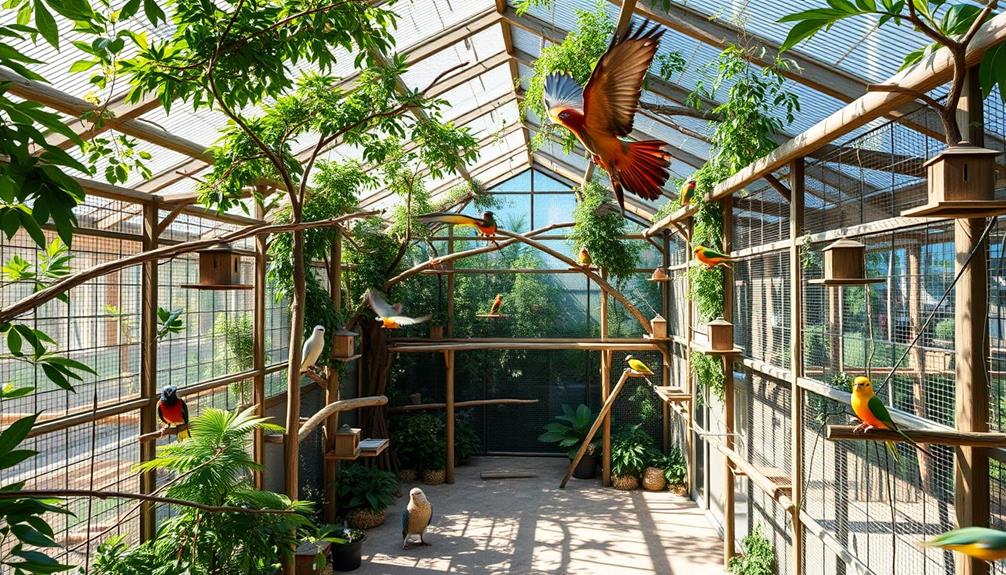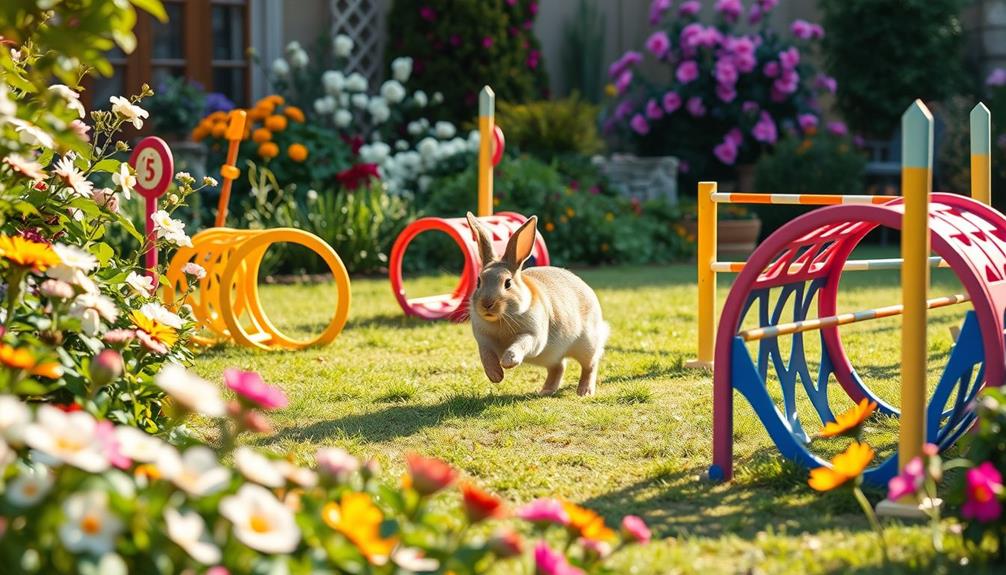When designing an aviary for breeding birds, prioritize their safety and comfort. Use sturdy materials like 2×4 timber and wildlife-proof mesh to protect them from predators. Confirm the aviary's size is at least 7' long, 4' wide, and 6' high to allow for natural behaviors. Create shaded areas and incorporate reliable water sources for hydration. Nest boxes need to be spacious and avoid overcrowding. Finally, consider your location to shield the aviary from harsh weather conditions. By focusing on these essential aspects, you can foster a nurturing environment for your feathered friends, and there's more to explore on how to enhance their habitat further.
Key Takeaways
- Utilize sturdy construction materials like 2×4 timber and wildlife-proof mesh to ensure durability and safety for breeding birds.
- Design aviaries with a minimum size of 7' long x 4' wide x 6' high to accommodate social behaviors and nesting needs.
- Incorporate reliable utilities, including fresh water sources and electricity for heating, to maintain a comfortable environment for the birds.
- Strategically place nesting boxes and maintain wide aisles for easy access, cleaning, and to reduce stress among birds.
- Implement daily maintenance routines, such as cleaning and monitoring bird health, to prevent illness and promote well-being.
Importance of Aviaries
Aviaries play an indispensable role in providing safe and nurturing environments for breeding birds. They serve as non-exploitive homes for rescued domestic pigeons and doves that can't survive in the wild, considerably enhancing their quality of life.
The design of an aviary is fundamental for the welfare of breeding birds, requiring sturdy construction to protect against predators and a layout that accommodates their social behaviors and nesting needs. Additionally, creating a space that allows for natural behaviors is just as important as guaranteeing safety, as unique dog names can reflect the personality of the birds, much like how we choose names for our pets.
Creating an aviary of at least 7' long x 4' wide x 6' high is essential, as larger spaces encourage natural behaviors and reduce stress among breeding pairs. You'll want to include important features like sheltered perching areas and nesting boxes, with minimum dimensions of 12"x12"x12". These elements are key for supporting their physical and mental well-being.
Proper care and maintenance in the aviary, including daily cleaning, fresh water access, and appropriate feeding practices, are crucial to prevent disease and maintain healthy breeding conditions.
Key Design Principles

How can effective design principles enhance the well-being of breeding birds? To start, constructing your aviary with sturdy materials, like 2×4 timber, guarantees durability and protection from predators and harsh weather.
It's crucial to use wildlife-proof mesh with openings no larger than 0.5 inches; this keeps your birds safe and prevents escapes. Incorporating natural materials, such as wood, in your aviary design can create a more inviting and comfortable atmosphere for your birds, resonating with the neutral color palettes trend in modern decor.
While a minimum size of 7' long x 4' wide x 6' high is recommended for a few birds, larger dimensions allow for increased social interaction and natural behaviors. Incorporating sheltered areas, proper ventilation, and ample natural light creates a healthy environment that supports breeding.
Nest boxes are another key element in your design. Each box should be at least 12"x12"x12" for every pair of birds, providing comfort and reducing conflicts among them.
Size and Space Requirements

When setting up your aviary, you'll want to take into account the minimum space dimensions to guarantee your birds' comfort and well-being.
Aim for a minimum size of 7' long by 4' wide by 6' high, but if you can go larger, your birds will benefit from increased space for socialization and natural behaviors.
It's important to remember that incorporating elements of minimalist living can enhance the aviary environment, allowing for a more naturalistic setting.
Utilizing horizontal space effectively is key, so think about longer, rectangular designs that promote flight and activity.
Minimum Space Dimensions
Guaranteeing that your breeding birds have enough space is fundamental for their well-being and social interactions. The minimum space dimensions for an aviary housing a few breeding pairs should be at least 7 feet long, 4 feet wide, and 6 feet high. This size allows for adequate flight and social interaction, which are essential for their health.
Additionally, providing opportunities for outdoor play can stimulate their natural instincts and improve their overall mood. However, if you can provide a large aviary, ideally measuring 8 feet by 8 feet or more, you'll create even better living conditions. A larger space encourages natural behaviors and helps reduce stress among birds.
When designing your aviary, consider the shape as well. Longer and rectangular designs offer better flight opportunities, while cube-shaped aviaries may limit movement. Each nesting pair of birds needs a minimum nest box size of 12 inches by 12 inches by 12 inches to guarantee comfort and minimize conflicts.
Don't forget about accessibility, either; ample aisle space is essential for easy feeding, cleaning, and care routines. By focusing on these minimum space dimensions, you'll foster a safe and nurturing environment for your breeding birds.
Space Utilization Strategies
To make the most of your aviary's space, it's vital to evaluate both size and layout carefully. When you design your aviary, consider the following space utilization strategies to create an ideal environment for your breeding birds:
– Minimum Dimensions: Aim for at least 7' long x 4' wide x 6' high. Larger dimensions like 8' x 8' x 6'+ enhance flight opportunities.
Additionally, guaranteeing proper ventilation and natural light can greatly improve your birds' overall well-being, as outlined in essential items for a home cleaning kit.
- Horizontal Space: Opt for longer, rectangular aviaries instead of cubic designs for better bird movement and socialization.
- Nest Box Placement: Verify nest boxes are at least 12"x12"x12" to provide comfort and minimize conflict among pairs.
Inside the aviary, maintaining wide aisles is necessary for easy access and cleaning.
Strategically place your nest boxes to avoid overcrowding, which can lead to stress.
Also, incorporate designated open areas for feeding and supplies, assuring birds feel safe and comfortable.
Location Considerations

Choosing the right location for your aviary is crucial for the health and happiness of your breeding birds. Start by selecting a sunny spot that also offers shaded areas, allowing your birds to bask in sunlight for vitamin D3 synthesis while protecting them from harsh weather.
Additionally, consider incorporating sustainable energy solutions like geothermal energy to power any necessary heating or cooling systems in your aviary. Aim for a minimum aviary size of 7' long x 4' wide x 6' high, as larger dimensions encourage social interactions among your birds.
Accessibility is critical; place your outdoor aviary where you can easily maintain and clean it. Ideally, it should be visible from your living areas, letting you interact with your birds regularly.
Also, consider sheltering your aviary from strong winds and direct rain to keep the environment stable and stress-free for your birds.
Lastly, pay attention to local wildlife. Verify your aviary is secure against potential predators and pests to provide a safe habitat for your breeding birds.
Construction Materials

When choosing materials for your aviary, it's crucial to prioritize both safety and durability.
Consider options like zoo mesh or stainless steel mesh to protect your birds from predators while ensuring long-lasting use. Additionally, using materials that are resistant to weathering and easy to clean can help maintain a healthy environment for your birds.
To improve air quality within the aviary, consider incorporating air purifiers which can greatly reduce allergens and harmful particles.
Moreover, heavy gauge PVC piping can provide the structural stability you need to withstand environmental challenges.
Ideal Material Selection
In constructing a safe and durable aviary for breeding birds, selecting the right materials is essential. The materials you choose will play a significant role in guaranteeing the health and safety of the birds, particularly by preventing any potential harm from toxic substances or unsafe structures.
Understanding the characteristics of materials, such as avoiding those linked to narcissistic behaviors, is key to creating a secure environment. Here are some ideal options:
- Zoo mesh: This durable and safe material is priced at approximately $30-40 per meter, making it a cost-effective choice for aviaries.
- Stainless steel: It's non-toxic and prevents escapes and predator access, costing around $50 for 10 feet. This is a strong option for a well-built aviary.
- Powder-coated panels: At about $1100 for an 8×8 aviary, these panels are weather-resistant and provide an attractive finish.
Additionally, using heavy gauge PVC piping for framing guarantees strength and resistance to environmental wear.
Avoid toxic materials like chain link and galvanized hardware, as these can pose health risks to your birds.
By carefully selecting materials, you can create a safe haven that not only protects breeding birds but also aids in animal rescue efforts.
Structural Stability Considerations
To guarantee your aviary remains safe and functional, structural stability must be a top priority. Start by using sturdy materials like 2×4 timber for the framework. This choice guarantees durability against environmental stresses, providing a solid foundation for your aviary.
Incorporating a double mesh layer enhances security, preventing wildlife intrusions while still allowing you to maintain visibility for your birds. Additionally, using budget-friendly options can help you allocate resources effectively without compromising on quality.
Consider using heavy gauge PVC piping for frame construction. It offers both strength and resistance to weather-related wear, making it an excellent choice for outdoor environments. When it comes to flooring, cement is a practical option. It prevents digging by predators and provides a robust base that contributes to the overall structural stability of your aviary.
As you build, pay attention to the joints. Opt for screws instead of nails, as they improve durability and make disassembly easier if you need to make repairs later on.
Maintenance and Care

Proper maintenance and care are essential for keeping your aviary thriving and your birds healthy. By following a few simple practices, you can guarantee a clean and safe environment for your feathered friends. Engaging the whole family in these maintenance tasks can also promote creative bonding activities while teaching children about responsibility and animal care.
- Daily cleaning prevents waste buildup and reduces illness risk. Smooth, sloped surfaces are ideal for easier maintenance.
- Provide fresh water daily for both drinking and bathing. Aim for a depth of 2-4 inches and have at least two water sources to assure accessibility.
- Position food dishes on the ground to support the natural foraging behavior of your birds. A dinner-plate-sized dish (about 1 cup of feed) is recommended for every four pigeons.
Regularly monitor your birds for any signs of stress or illness. This proactive approach allows for timely interventions.
Schedule veterinary check-ups to maintain their health and guarantee cleanliness to prevent disease outbreaks in your aviary.
Utilities and Amenities

When setting up your aviary, you'll want to guarantee a reliable water supply and easy access to power.
A clean and abundant water source is vital for your birds' health, while electricity can support essential heating and lighting systems.
These utilities make a significant difference in creating a comfortable and stimulating environment for breeding birds.
Water Supply Essentials
Providing fresh, clean water is essential for the health and well-being of breeding birds in your aviary. To guarantee they thrive, you must provide enough water sources daily. Aim for at least two, allowing for both drinking and bathing.
Here are some key water supply essentials to keep in mind:
- Optimal Bathing Depth: Maintain water depth between 2-4 inches for safe bathing.
- Strategic Placement: Position water dishes on the ground to align with natural foraging behaviors.
- Regular Maintenance: Clean water containers frequently to prevent bacterial growth.
For every four pigeons, a dinner-plate-sized dish (about 1 cup) is recommended. Daily monitoring of water availability is vital, as is keeping an eye on cleanliness.
Additionally, incorporating water features like small ponds or fountains can enhance the aviary's environment while providing extra hydration and enrichment.
By taking these steps, you'll not only guarantee your breeding birds stay healthy but also create a vibrant aviary space that keeps them happy.
Power Accessibility Considerations
Guaranteeing power accessibility in your aviary is essential for creating a comfortable and safe environment for breeding birds. Maintaining ideal temperature ranges, typically between 60-80°F, requires reliable heating and cooling systems. These systems not only help regulate temperature but also contribute to the overall health and comfort of your birds.
Incorporating low voltage lighting systems with timers is another smart move. It guarantees consistent illumination, promoting healthy circadian rhythms without the risk of overheating or electrical hazards.
You'll want to provide power outlets throughout the aviary to support air filtration systems, which improve air quality by reducing feather dust and dander.
When installing heaters and fans, safety should be your top priority. Use protective measures like PVC conduit to prevent birds from chewing on cords, which can lead to dangerous electrical hazards.
Additionally, consider planning for future power needs. This foresight allows for the easy addition of more lighting or utilities for water features, further enhancing your aviary's environment.
With these power accessibility considerations in mind, you'll create a nurturing space that supports the well-being of your breeding birds.
Planting Strategies

In the pursuit of creating a thriving aviary, thoughtful planting strategies are essential for fostering a healthy environment for breeding birds.
By integrating a variety of plants, you can enhance the aviary space considerably. Consider these key strategies:
- Incorporate individual planters at ground level to manage plant destruction and enrich foraging experiences.
- Select non-toxic herbs and small plants that provide natural food sources, improving the birds' diet and overall health.
- Rotate and refresh plants regularly to guarantee continuous availability of fresh food and water options.
Future Design Innovations

As aviary design evolves, future innovations promise to revolutionize how we create spaces for breeding birds. One key advancement is the use of modular structures, which offer flexibility in layout and can be easily adjusted to accommodate various bird species. This adaptability not only enhances the comfort of the birds but also simplifies maintenance and cleaning.
Incorporating advanced materials like lightweight, durable mesh can notably improve safety by providing better predator protection while ensuring proper ventilation. These materials help create an environment that prioritizes the comfort and well-being of breeding birds.
Automated climate control systems will also play an essential role in future aviary designs. By integrating temperature and humidity monitoring, you can optimize the aviary environment, promoting successful breeding and overall bird health.
Innovations in lighting, such as full-spectrum LED systems with programmable timers, will mimic natural sunlight patterns, supporting the birds' circadian rhythms.
Lastly, exploring sustainable practices, like rainwater harvesting systems for drinking and bathing, can foster eco-friendly care for your aviary inhabitants.
These future innovations won't only enhance the aviary experience but also contribute to the welfare of breeding birds.
Community Support Resources

A wealth of community support resources is available to help you navigate the intricacies of bird care and aviary maintenance. These resources not only provide guidance but also connect you with others who share your passion for aviculture.
- Palomacy Help Group: A fantastic platform for sharing experiences and advice on bird care.
- Monthly Newsletters: Stay informed about community activities, needs, and resources available for your breeding birds.
- Volunteer Opportunities: Get involved through fundraising events, like auctions, that support avian welfare.
Engaging with these community support resources can make a significant difference in your journey as a bird caretaker. You'll find educational content, including blogs and FAQs, that offer valuable insights into best practices for aviary design.
Additionally, advocacy efforts encourage you to participate in petitions and support organizations focused on bird welfare, further enhancing outreach and community involvement.
Frequently Asked Questions
How to Make a Room Safe for Birds?
To make a room safe for birds, secure windows with wildlife-proof mesh, remove toxic plants, use non-toxic paints, install safety latches, and provide plenty of perches and enrichment items for mental and physical stimulation.
How Do You Secure a Bird Aviary?
Imagine a fortress for your feathered friends. To secure a bird aviary, use wildlife-proof mesh, solid barriers, and heavy PVC frames. Regularly check for hazards, and install quick-closing doors to keep them safely inside.
How Much Does It Cost to Build a Bird Aviary?
Building a bird aviary typically costs between $1,000 and $5,000. Your expenses depend on size, materials, and features. Don't forget to budget for extras like heating, ventilation, and installation of water and power supplies.
How to Build an Aviary for Birds of Prey?
"Birds of a feather flock together," so to build an aviary for birds of prey, use sturdy materials, guarantee height and space, add natural perches, secure latches, and provide sunlight, shade, and water.
Conclusion
Creating an aviary isn't just about walls and roofs; it's about crafting a sanctuary where breeding birds can thrive like wildflowers in a sunlit meadow. By considering size, location, and thoughtful design, you're not just building a space but nurturing life itself. Embrace innovative ideas and community support, and you'll transform your aviary into a vibrant haven, allowing these feathered beauties to flourish and sing their joyful songs for all to hear.










